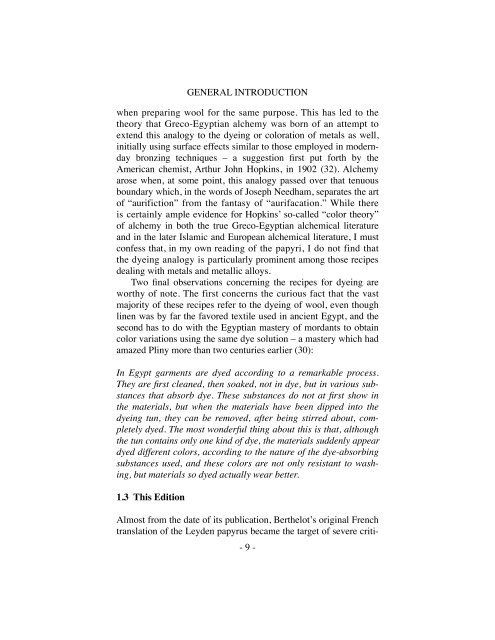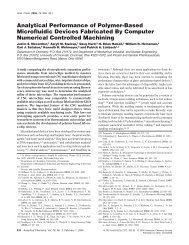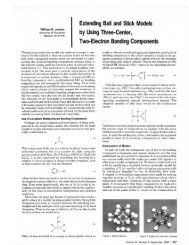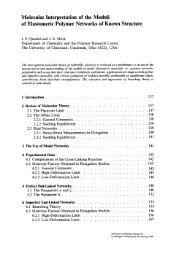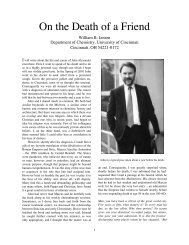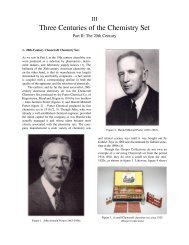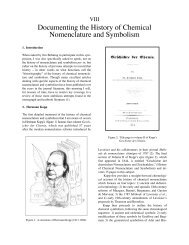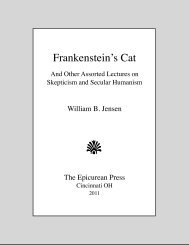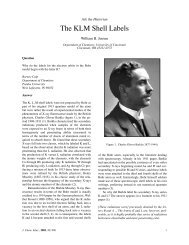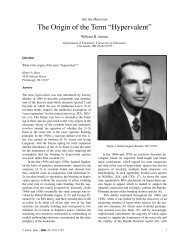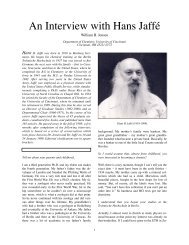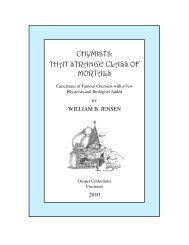The Leyden and Stockholm Papyri - University of Cincinnati
The Leyden and Stockholm Papyri - University of Cincinnati
The Leyden and Stockholm Papyri - University of Cincinnati
You also want an ePaper? Increase the reach of your titles
YUMPU automatically turns print PDFs into web optimized ePapers that Google loves.
when preparing wool for the same purpose. This has led to the<br />
theory that Greco-Egyptian alchemy was born <strong>of</strong> an attempt to<br />
extend this analogy to the dyeing or coloration <strong>of</strong> metals as well,<br />
initially using surface effects similar to those employed in modernday<br />
bronzing techniques – a suggestion first put forth by the<br />
American chemist, Arthur John Hopkins, in 1902 (32). Alchemy<br />
arose when, at some point, this analogy passed over that tenuous<br />
boundary which, in the words <strong>of</strong> Joseph Needham, separates the art<br />
<strong>of</strong> “aurifiction” from the fantasy <strong>of</strong> “aurifacation.” While there<br />
is certainly ample evidence for Hopkins’ so-called “color theory”<br />
<strong>of</strong> alchemy in both the true Greco-Egyptian alchemical literature<br />
<strong>and</strong> in the later Islamic <strong>and</strong> European alchemical literature, I must<br />
confess that, in my own reading <strong>of</strong> the papyri, I do not find that<br />
the dyeing analogy is particularly prominent among those recipes<br />
dealing with metals <strong>and</strong> metallic alloys.<br />
! Two final observations concerning the recipes for dyeing are<br />
worthy <strong>of</strong> note. <strong>The</strong> first concerns the curious fact that the vast<br />
majority <strong>of</strong> these recipes refer to the dyeing <strong>of</strong> wool, even though<br />
linen was by far the favored textile used in ancient Egypt, <strong>and</strong> the<br />
second has to do with the Egyptian mastery <strong>of</strong> mordants to obtain<br />
color variations using the same dye solution – a mastery which had<br />
amazed Pliny more than two centuries earlier (30):<br />
In Egypt garments are dyed according to a remarkable process.<br />
<strong>The</strong>y are first cleaned, then soaked, not in dye, but in various substances<br />
that absorb dye. <strong>The</strong>se substances do not at first show in<br />
the materials, but when the materials have been dipped into the<br />
dyeing tun, they can be removed, after being stirred about, completely<br />
dyed. <strong>The</strong> most wonderful thing about this is that, although<br />
the tun contains only one kind <strong>of</strong> dye, the materials suddenly appear<br />
dyed different colors, according to the nature <strong>of</strong> the dye-absorbing<br />
substances used, <strong>and</strong> these colors are not only resistant to washing,<br />
but materials so dyed actually wear better.<br />
1.3 This Edition<br />
GENERAL INTRODUCTION<br />
Almost from the date <strong>of</strong> its publication, Berthelot’s original French<br />
translation <strong>of</strong> the <strong>Leyden</strong> papyrus became the target <strong>of</strong> severe criti-<br />
- 9 -


